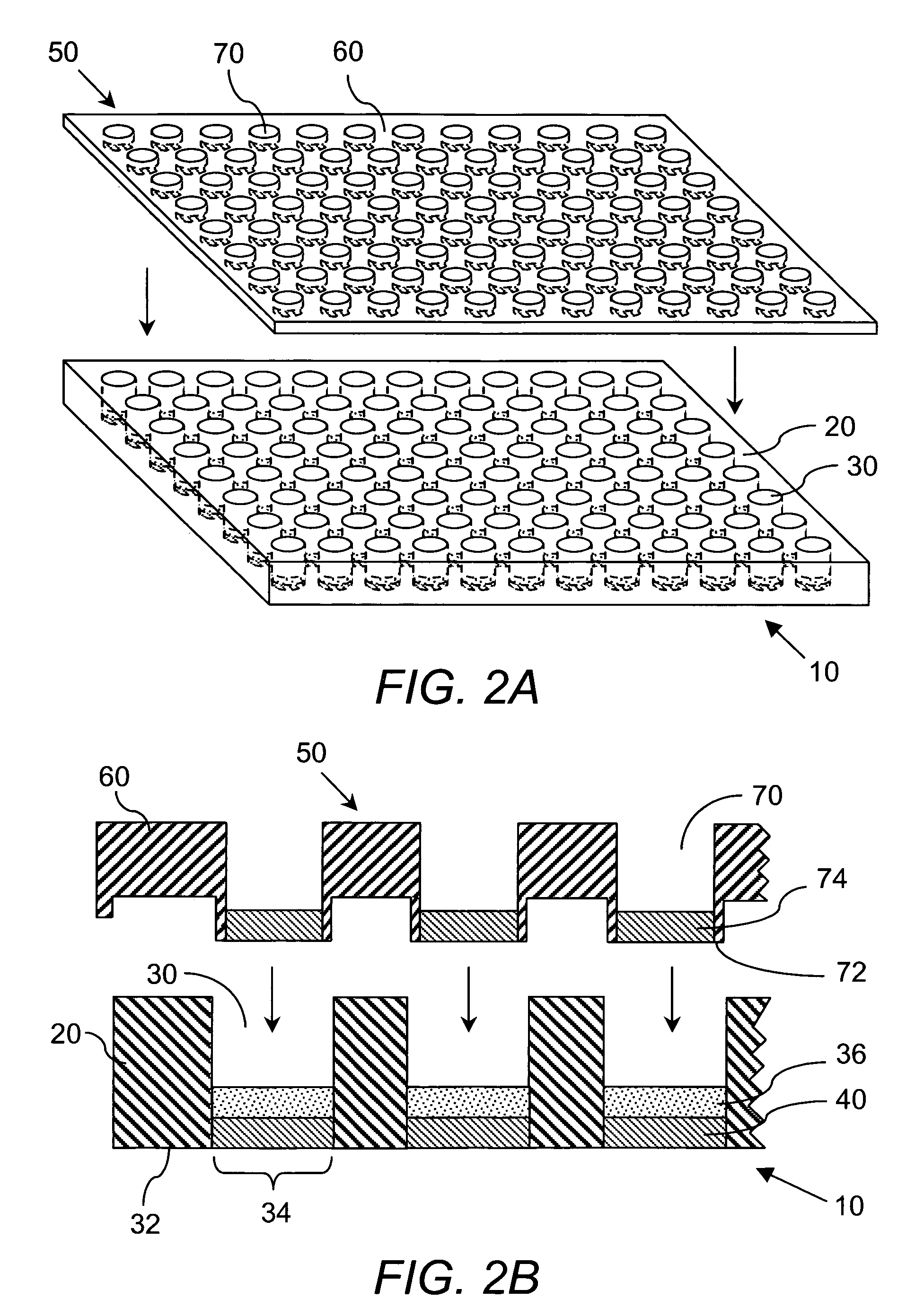Apparatus, kits and methods for evaluating binding interactions, for detecting and quantifying binding molecules, and for sample preparation
a technology of binding interactions and kits, applied in the field of apparatus, kits and methods for evaluating binding interactions, can solve the problems of inability to reliably analyze the extent of binding to a target protein using available methods, laborious and slow conventional membrane-based methods, and inability to validate the measurement of the unbound fraction, etc., to achieve the effect of low molecular weight components
- Summary
- Abstract
- Description
- Claims
- Application Information
AI Technical Summary
Benefits of technology
Problems solved by technology
Method used
Image
Examples
example 1
Evaluation of Dextran-Coated Charcoal (DCC) Device in 96-Well Format
[0225] The purpose of this study was to evaluate the scaling down and adaptation of a DCC-based device to a 96-well format.
Experimental:
[0226] Preparation of DCC plate. The device used in these studies is identified by the name ACCUPRO™, a propriety mark of Qualyst, Inc. Briefly, prepare a slurry of 0.5 grams of Sigma brand dextran coated charcoal (part# C6197-20G) in 10 mL of 10% w / w dextran (64K-76K) in phosphate buffer saline, pH 7.2 (PBS). Add 50 μL of this slurry (2.5 mg total DCC) to a well in a Millipore HTS DV, 0.65 μm, Hydrophil Durapore® 96-well filter plate (part # MSDVN6510). Apply centrifugal force to move the DCC to the bottom of the plate. Load 250 μL of PBS to the well and layer on top of the PBS a disk of 0.65 μm, Hydrophil Durapore® filter membrane cut to the diameter of the well. Apply centrifugal force to pass the PBS through the DCC bed and press the filter membrane against the DCC bed. Appl...
example 2
Analysis of α1-Acid Glycoprotein (AAG) in the Presence of HSA
[0233] The purpose of this study was to use the 96-well format ACCUPRO™ device described in Example 1 for the analysis of the protein, AAG, in the presence of HSA.
Experimental:
[0234] Preparation of DCC plate. The same procedure was utilized as was described in Example 1.
[0235] Set-Up of Incubation Study. Under typical human physiological conditions, the concentrations of HSA and AAG in human plasma are approximately 588 μM (40 mg / mL) and 20 μM (0.9 mg / mL), respectively. One stock solution of HSA and AAG was prepared in PBS at these physiological concentrations. A second stock solution was prepared with the same HSA concentration, but with AAG reduced 50% (10 μM). These two stock solutions were diluted 1:3 with PBS, yielding two working solutions of HSA / AAG at 147 μM / 5 μM and 147 μM / 2.5 μM. In duplicate, a 50 μL aliquot of each working solution was 19 μM in chlorpromazine. Chlorpromazine is reported to be 95-98% plasma...
example 3
Evaluation of Percent Recovery of Ibuprofen and Four Analogs from Both HSA and Human Plasma Utilizing the 96-Well ACCUPRO™ Device
[0238] This experiment was carried out to determine if the 96-well ACCUPRO™ device can discriminate drugs reported as greater than 99% bound in plasma.
Experimental:
[0239] Preparation of DCC plate. Same as previously described in Example 1 except the filter on top of the DCC bed is a Millipore HTS, BV 1.2 μM Hydrophil Durapore® Membrane part # MSBVN1210. To prepare DCC plate with a 5 mg bed, add 100 μL of 0.5 g / mL DCC slurry. To prepare a 10 mg DCC bed, add 100 μl of 0.5 g / mL DCC slurry, apply centrifugal force to pack bed, add an additional 100 μL DCC slurry. A (−) DCC control is prepared by loading 250 μL PBS to an empty well followed by a 1.2 μM top filter and applying centrifugal force.
[0240] Set-Up of Incubation Study. Prepare 40 mg / mL HSA in PBS. Prepare samples in triplicate for both (+) DCC and (−) DCC extraction of 50 μL HSA or 50 μL human pla...
PUM
| Property | Measurement | Unit |
|---|---|---|
| average molecular weight | aaaaa | aaaaa |
| thickness | aaaaa | aaaaa |
| molecular weight | aaaaa | aaaaa |
Abstract
Description
Claims
Application Information
 Login to View More
Login to View More - R&D
- Intellectual Property
- Life Sciences
- Materials
- Tech Scout
- Unparalleled Data Quality
- Higher Quality Content
- 60% Fewer Hallucinations
Browse by: Latest US Patents, China's latest patents, Technical Efficacy Thesaurus, Application Domain, Technology Topic, Popular Technical Reports.
© 2025 PatSnap. All rights reserved.Legal|Privacy policy|Modern Slavery Act Transparency Statement|Sitemap|About US| Contact US: help@patsnap.com



